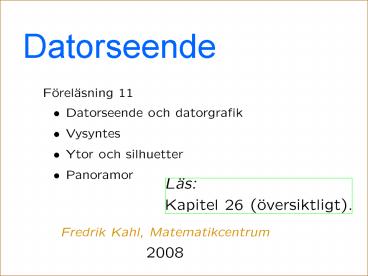Datorseende PowerPoint PPT Presentation
Title: Datorseende
1
Datorseende
TexPoint fonts used in EMF AA
2
What is computer vision?
- Image Understanding (AI, behavior)
- Computer emulation of human vision
- A sensor modality for robotics
- Inverse of Computer Graphics
3
Intersection of vision and graphics
4
Image-based rendering
- What is image-based rendering?
- The synthesis of new views of a scene from
pre-recorded pictures - Why?
- Many applications
5
Example Panoramic mosaics
6
Image-based rendering
- How?
- General pipeline
7
Image-based rendering
- Three approaches
- 3D model construction from image sequences
- Transfer-based image synthesis
- Light field
8
Approach 1 3D model construction from image
sequences
- Techniques that first recover a three dimensional
scene model from a sequence of pictures, then
render it with classical computer graphics tools - Scene modelling from
- Registered images
- Unregistered images
9
Scene modellingfrom registered images
- All images are registered in the same global
coordinate system - What kinds of reconstruction?
- Volumetric reconstruction
- Surface reconstruction
- Depth maps
10
Surfaces and their outlines
Occluding contour
Camera centre
Image contour
11
Surfaces and their outlines
Shadow boundary
The viewing cone
12
Volumetric reconstruction
- It is impossible to uniquely reconstruct an
object from its image contours. Why? - Two main constraints imposed on a solid shape by
its image contours - The shape should lie in the intersection of all
viewing cones - The cones should be tangent to its surface
- Techniques
- Voxel carving
- Polyhedral approximation
- Smooth surface fitting
13
Smooth surfaces from image contours
- Example by Ponce Spline parametrization which
minimizes the energy
14
(No Transcript)
15
Virtualized RealityTM
- Capture synchronized video from a full hemisphere
of views. - Perform new view generation
16
Virtualized RealityTM
- Spatio-Temporal View InterpolationS. Vedula, S.
Baker, and T. KanadeEurographics Workshop on
Rendering, June, 2002.
17
Virtualized RealityTM
- Build 3D model and compute 3D scene flow,
interpolate view and time.
18
FILM!
19
Scene modellingfrom unregistered images
- Not necessary to reconstruct all images into one
global coordinate system - A priori model of the scene
20
Image-based modeling
21
Façade
- Select building blocks
- Align them in each image
- Solve for camera poseand block parameters(using
constraints)
22
View-dependent texture mapping
- Determine visible cameras for each surface
element - Blend textures (images) depending on distance
between original camera and novel viewpoint
23
FILM!
24
Model-based reconstruction from one image
J-E Solem, F. Kahl, 2005
25
(No Transcript)
26
Approach 2 Transfer-based image synthesis
This example is based on computing consistent homo
graphies between all planes (B. Johansson, 2003)
27
View Morphing
- Morph between pair of images using epipolar
geometry Seitz Dyer, SIGGRAPH96
28
Affine view synthesis
- På tavlan!
29
(No Transcript)
30
Approach 3 The light field
31
What is light?
- Electromagnetic radiation (EMR) moving along rays
in space - R(l) is EMR, measured in units of power (watts)
- l is wavelength
- Light field
- We can describe all of the light in the scene by
specifying the radiation (or radiance along all
light rays) arriving at every point in space and
from every direction
32
Ray
- Constant radiance
- time is fixed
- 5D
- 3D position
- 2D direction
33
Line
- Infinite line
- 4D
- 2D direction
- 2D position
- non-dispersive medium
34
Image
- What is an image?
- All rays through a point
- Panorama
35
Panoramic Mosaics
- Convert panoramic image sequence into a
cylindrical image -
36
Image
- Image plane
- 2D
- position in plane
37
Object
- Light leaving towards eye
- 2D
- just dual of image
38
Object
- All light leaving object
39
Object
- 4D
- 2D position (on surface)
- 2D direction
40
Object
- All images
41
The light field
- Summary
- Capture as many images as possible
- Store them in a smart way
- Discretize rays to synthesize new images
42
Complex Light Field acquisition
- Digital Michelangelo Project
- Marc Levoy, Stanford University
- Lightfield (night) assembled by Jon Shade
43
Surface Light Fields
- Wood et al, SIGGRAPH 2000
44
Sammanfattning
- Vysyntes och bildbaserad modellering
- Nära relationer till datorgrafik
- Tre strategier
- Först 3D modell, sedan använd datorgrafik
- Transfer-baserad vysyntes
- Light field

